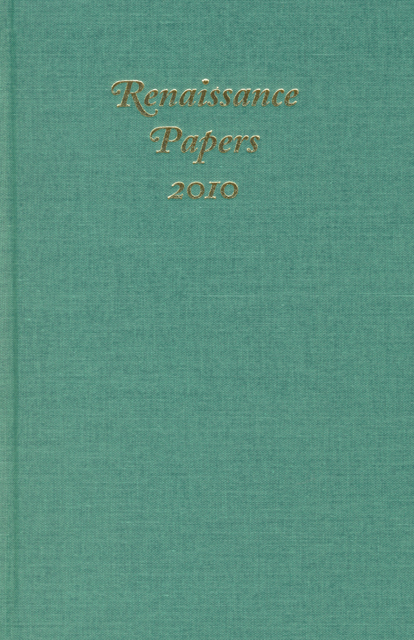Book contents
- Frontmatter
- Contents
- Renaissance Papers
- Aretino’s Life and His Afterlife in England
- Mixing Genres in George Peele’s David and Bethsabe
- Royal Prerogative versus the Common Law in A View of the Present State of Ireland and The Faerie Queene, Book 5
- The Limits of Clowning in the Age of Marprelate: The Anti-Martinist Tracts and 2 Henry VI
- Shakespeare’s Iago
- Francesco Patrizi da Cherso, Caravaggio, and the Metaphysics of Light
- Being John Donne in 1602
- The Problem of the Human in Sir Francis Bacon
- The Glamorous Echoes of Godly Print
- “More cullors than the Rainbowe caries”: Catholics, Cosmetics, and the Aesthetic Economy of Protestant England
Francesco Patrizi da Cherso, Caravaggio, and the Metaphysics of Light
Published online by Cambridge University Press: 10 February 2023
- Frontmatter
- Contents
- Renaissance Papers
- Aretino’s Life and His Afterlife in England
- Mixing Genres in George Peele’s David and Bethsabe
- Royal Prerogative versus the Common Law in A View of the Present State of Ireland and The Faerie Queene, Book 5
- The Limits of Clowning in the Age of Marprelate: The Anti-Martinist Tracts and 2 Henry VI
- Shakespeare’s Iago
- Francesco Patrizi da Cherso, Caravaggio, and the Metaphysics of Light
- Being John Donne in 1602
- The Problem of the Human in Sir Francis Bacon
- The Glamorous Echoes of Godly Print
- “More cullors than the Rainbowe caries”: Catholics, Cosmetics, and the Aesthetic Economy of Protestant England
Summary
Just as Aristotle discovered the prime mover by way of motion, so in Panaugia I find it by way of lumen and lux and then, in Pancosmia, by way of a Platonic method I descend to the products of light.
—Francesco Patrizi da Cherso, November 1587, FerraraIn the history of art, the paintings of Michelangelo Merisi da Caravaggio (1571–1610) are placed chronologically at the end of the Late Mannerist period and, therefore, at the inception of what came to be called the Baroque. Unquestionably, his works signal a major transition. The years in Rome between 1592 and 1606 when he executed his revolutionary works were a time in which principal philosophical, theological, and scientific ideas were being reconsidered. In the wake of the Protestant Reformation and the Council of Trent (1543–65) there was a complex tension between the prevailing Aristotelian philosophy, Neoplatonism, and the rise of a new kind of Platonism that first appeared in Ferrara. In Rome, where these ideas coalesced into a single spiritual, cultural, and philosophical milieu, it seems in hindsight that the visual arts would, to at least some degree, be affected.
Caravaggio arrived in Rome in 1592, the same year as Francesco Patrizi da Cherso (1529–97). The former came to better his artistic fortunes, the latter by invitation of the newly elected Pope Clement VIII (Aldobrandini) to lecture at the Sapienza, where the Pope had created a chair in Platonic philosophy. From 1592 until 1597 many important scholars, intellectuals, and literati attended his lectures there.
Patrizi and Caravaggio were both working within the same immediate geographical area adjacent to the Sapienza between 1594 and 1597. Two blocks from the Sapienza was the church of San Luigi dei Francesi, the site of Caravaggio’s St. Matthew cycle (1599–1602). Across from San Luigi was the palace of Vincenzo Giustiniani, one of Caravaggio’s most discriminating patrons and a collector of antique sculpture. It was Giustiniani’s brother, Benedetto, who, in 1592, was appointed by the Jesuits to evaluate the philosophy of Patrizi for the Inquisition. In the same immediate area was the Palazzo Madama, the home of another important patron of Caravaggio, Cardinal Francesco Maria del Monte, who gave quarters to the artist in 1594.
- Type
- Chapter
- Information
- Renaissance Papers 2010 , pp. 77 - 86Publisher: Boydell & BrewerPrint publication year: 2011



